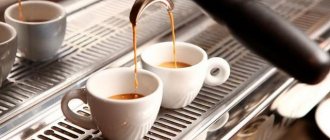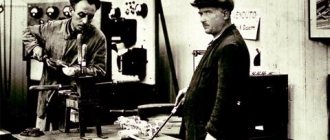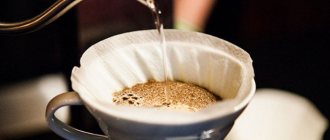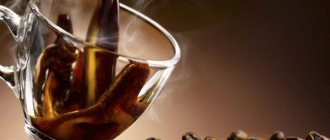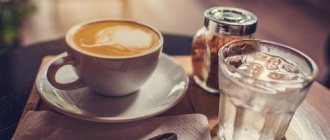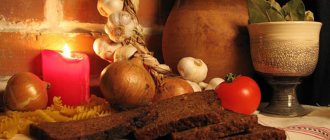Filters for coffee makers - varieties
True coffee connoisseurs know that its taste depends not only on the quality of the ground beans, but also on the filtration of the finished drink. Coffee maker filters are made from a variety of materials. They have different characteristics and costs.
Paper
The most popular type of filter, which has been used for more than 100 years. In production, both unbleached brown paper sheets and white ones are used. Brown products that are not bleached and do not have glue in the seams are considered the most environmentally friendly. However, they can impart a cardboard taste to the drink. White paper has no foreign odor.
The most expensive and high-quality products are made from bamboo.
Bamboo fibers ensure high purity of the finished drink and have no odor. The cost of such filters is high.
The main advantages of paper filters include:
- The porous, dense material traps even the smallest solid particles, filters natural alkaloid compounds and oily diterpenes, which contribute to increasing cholesterol levels in the human body.
- Used disposable paper products are discarded, preventing the possibility of fungi developing like reusable filters.
- They have a long shelf life.
- The installation and removal process is very simple.
- Used filters quickly decompose and do not harm the environment.
The main disadvantages include only the need to regularly purchase filters. When preparing a coffee beverage frequently, the cost of paper filtration can be significant.
Nylon
Some models of coffee makers have a plastic or metal cone covered with nylon as a filter element. Synthetic fibers are durable, hypoallergenic, and have a long service life. Reusable nylon filters can be used at least 60 times. The average cost per application is low.
The smallest particles of ground beans penetrate through the nylon mesh, so it is recommended to use medium and coarse grind coffee. The filtered grounds are immediately cleaned off, which increases the time required to prepare a cup of aromatic coffee.
Gold
Some manufacturers coat filter frame elements with nylon mesh with titanium nitride. The result is a product with a metallic golden sheen. The titanium coating increases the service life of the filter and makes it easier to clean.
Relative disadvantages include the high cost of the products and the inability to prepare a drink from finely powdered coffee. To maintain the hygiene of the filter, it must be thoroughly cleaned of grounds particles.
Fabric
In the production of fabric models, cotton, muslin or hemp fabrics are used. Textile fibers, when interwoven, form large pores, which allows some of the grounds to leak into the cup. Fabric filters are reusable and have a shelf life of no more than 180 days if used daily.
The disadvantages include the rapid loss of attractive appearance, since coffee darkens the fibers of the fabric.
Cleaning must be thorough and timely. Textile filter elements are affordable.
Metal
The products are distinguished by their strength and durability. Most often, metal filters are made of stainless steel. The service life is unlimited, the risk of mechanical damage is minimal. Both manual cleaning and dishwasher cleaning are allowed.
The stainless steel mesh does not retain aromatic oils or alkaloid derivatives. The drink is strong, with a small amount of grounds at the bottom. From an environmental point of view, metal filters are optimal because they do not require regular replacement.
Making delicious filter coffee
Step 1
Pour the required amount of water into the coffee maker reservoir. Some coffee makers do not automatically turn off after a few minutes and only turn off when the water in the reservoir runs out. That is, more water can pass through coffee than we need. We'll talk about the proportion of water to coffee a little later.
Water is not just an ingredient for making coffee - water can dissolve a limited amount of substances in a certain time. How many coffee particles it can accept depends on how saturated it is initially. Water that is too soft has few impurities and dissolves too many particles in the coffee. And vice versa - hard water already contains a lot of impurities and does not dissolve enough coffee particles. As a result, coffee turns out tasteless with hard water, and overly bright with soft water.
Another goal that we pursue when choosing the “right” water is to avoid problems with the coffee machine.
If you cook a lot and often, install a household filter; if not, buy bottled water, for example “Holy Source” - this water has an excellent composition for making coffee: mineralization 100–500 mg/l, calcium less than 80 mg/l.
The main rules when choosing water for coffee: transparent, odorless, mineralization from 80 to 180 mg/l (100 would be very good), chlorine level is zero, neutral pH level - 6.5-7.5 (good if equal to 7). A high pH will result in tasteless or “flat” coffee, while a low pH will result in more acidity in the coffee.
Step 2
Install a mesh or paper filter into the coffee hopper. Our recommendation is to use Melitta bleached paper filters. This is not only more hygienic, but also significantly less coffee dust gets into the drink.
In turn, Melitta filters, in addition to different sizes, come in different densities:
- Original - basic filters. Similar in structure to Hario filters
- Gourmet - These filters allow more coffee oils to pass through.
- Gourmet Intense - these filters allow water to pass through more slowly and brewing lasts longer than coffee with such filters that is richer. Our opinion is that if there is not enough density in the taste, it is better to add more grams of coffee to the same volume of water.
- Gourmet Mild - these filters can allow coffee dust to pass through.
Step 3: Grinding
You will need a coffee grinder with burrs suitable for filter grinding. It can be either a manual or electric coffee grinder. The main thing is the absence of small fractions that remain after grinding. They make the coffee taste less “clean” and affect the richness of the taste. This fine fraction will also clog the paper filter so much that the coffee will not leak at all.
We recommend using a grind that resembles large sea salt crystals and reducing it the next time you brew (without changing the proportion of water to coffee) if you find the drink slightly rich. Grind coffee, the weight of which can be calculated using the proportion 1:16 1 gram of coffee for every 16 milliliters (that is, 62.5 g of coffee per 1 liter) In order to quickly adjust the grinding, focus on the size of the sea salt crystals (on different coffee grinders this different meanings).
Step 4: Selecting Coffee
In our assortment of coffee, you can order not only high-quality grinding, but also consult on the choice of coffee. We also have coffee sets, for example, balanced (ideal balance of acidity, sweetness and bitterness) or trial (suitable for those who cannot decide on a choice).
Step 5
There is a kushina heating function - the coffee will remain hot for a very long time. When used this way, there is a risk of “baking” the coffee: if you leave the jug on the heat for more than an hour, the taste of the drink will deteriorate over time. If you turn off the heating, the coffee will soon cool down to room temperature, and not everyone likes cold coffee. The best option is to pour it into a heated thermos immediately after the drink is ready. This way it will cool much more slowly and remain warm for five hours.
Selecting filters by size
The main criterion for choosing a suitable product is the expected yield of the finished product. To prepare 1 serving, filter No. 1 is sufficient. If you need to make more coffee, then choose products for 2, 4 or 6 servings.
Filters 4 and 2, the difference between which is throughput, are the most popular. For a coffee maker flask with a volume of 0.6-0.8 liters, filter No. 2 is intended. If the flask volume is 1 - 1.2 liters, you should select filter No. 4. Some manufacturers offer models for preparing 8-12 servings of the drink.
A little history
A woman named Melitta Benz is believed to be the inventor of coffee filters. One day she found a very simple, but nevertheless extremely effective way to filter coffee during preparation. She simply added a piece of paper to a package through which boiling water was poured. The paper acted as a filter, and did an excellent job of this task. It's very similar to a Chemex or pour over.
In 1908, the woman received a patent for products of this type, and started her own small production. All this has led to the fact that Melitta currently occupies a leading position in this business.
How to make your own filter
In an emergency or to save money, it is possible to make a paper filter element with your own hands.
The main thing is the right choice of material. Office paper will not allow water to pass through well; thin newspaper paper may dissolve or tear. Towels, multi-layer napkins and paper handkerchiefs have maximum porosity and high filtering ability.
Here is the algorithm of actions:
- Choose a napkin or piece of towel without inscriptions or drawings. Dyes will dissolve with hot water and end up in the finished coffee, which is harmful to health.
- Draw a circle with a diameter of about 15 cm and cut it along the contour.
- The cut out circle is folded in half, then doubled again.
- Ground coffee is poured inside the resulting funnel.
- The filled filter is fixed in a funnel or used when brewing a drink in a cup.
It is also possible to make a durable filter element at home from fabric. Preference is given to cotton fabric of medium thickness. The washed cloth will filter the drink faster. An alternative material is gauze, medical bandage, and nylon products. These fabrics will need to be folded in several layers.
Maintenance and operation
To avoid the formation of an air lock, the internal filter is filled with water before installation and placed in a full tank. The devices do not require any maintenance.
Replacement frequency
| Filter brand | Model | Approximate service life (when processing an average of 10 liters of water per day) |
| Internal filter | ||
| DeLonghi | DLS | 60 days |
| Krups | Claris | 60 days |
| Saeco and Philips | Brita Intenza+ | 60 days |
| Bosch | Claris, Brita Intenza | 60 days |
| Jura | Claris | 60 days |
| Brita | AquaGusto 100 | 180 days |
| Main filter | ||
| Brita | Purity C300 | 1.5 years |
| Aquaphor | Morion DWM-101S | 6 months |
Dismantling the device and installing a new one is carried out according to the instructions. There is nothing complicated about the procedure.
Attention!
Regular replacement of the cartridge cannot be postponed until later. A clogged filter stops allowing water to pass through, which can cause damage to the hydraulic system.
Common problems when using homemade filters
Home-made filters cannot completely replace professional ones. With regular use, you may encounter some difficulties:
- the fibers of fabric models become more porous when reused. They absorb more oils, and the drink loses its strength and aroma;
- if textiles are washed using soap or powder, the taste of the coffee deteriorates;
- When using new gauze or bandage, an unpleasant medical aftertaste may occur in the finished drink.
Homemade filter elements are not recommended for permanent use.
If the coffee machine does not see water
A very common breakdown is when the coffee machine gives a signal that there is no water in the tank. No matter how much you pour the liquid, the error still does not disappear. What to do about it?
The main reason for this problem may lie in a clogged filter , which I wrote about above. The second point is a breakdown of the float or the water tank itself. If your coffee machine has a magnetic sensor to control the water level, that may be the problem.
What to do:
- First, you should pour water into the bunker and see if the float can float up. Perhaps it's stuck. You should check to see if anything has hit it, preventing it from coming to the surface. But basically, this is a signal for the need for cleaning. It's time to descale the machine and the cooking side;
- This part may be lost - a new one will need to be installed. In some models, this is only possible in conjunction with changing the liquid container;
- If your device has a magnetic sensor, which is often found in DeLonghi models, you should arm yourself with a strong magnet. If you put it on the float and pull it down, it should sink. If that's the case, that's it. By the way, the contacts of this part are constantly open; when a magnet is applied, they close, the board receives a signal about filling the tank with water, and the “add water” signal disappears from the screen. To check the serviceability, you should take a tester. If the part is working, the resistance is 1-2 ohms. If not, replacement is required.
I would like to draw your attention to the fact that you should not pour too hot or too cold water into the coffee machine, as this can cause such damage.
In addition to the float, airing of the system could occur . You should open the tap and pour water. Another point is a breakdown of the hall sensor. It is simply changed in the service. It costs a penny.
Filter for coffee machines Jura, Bosch, Saeco, Delonghi
Depending on the configuration of the coffee machine, it uses a metal, nylon filter element with a long service life, or disposable models. To replace a reusable filter cone, you should give preference to original components or study its characteristics and consider universal models.
Popular manufacturers of paper filters are Filtero, Melitta, Aksel KONOS, Topperr. The products are made from high quality materials and are suitable for drip coffee makers of standard models Jura, Bosch, Saeco, Delonghi. Purchase paper filter elements in packs of 40-240 pieces. It is possible to install a disposable filter without special skills.
Characteristics of Delonghi, Krups, Saeco and other cleaners
| Manufacturer | Product line | Peculiarities | Job resource | Price, rub.) |
| DeLonghi (Italy) | DLS | Delonghi 002 series for descaling. Performs the function of demineralization (softening) of water. Compatible with ETAM, ECAM, ESAM machines. | 50 liters | 1990 |
| Krups (Germany) | Claris | For Krups coffee machines. Removes chlorine, pesticides, impurities, and gets rid of plaque. Retains the full composition of minerals. | 50 liters | 2190 |
| Royal Philips / Saeco (Netherlands) | Philips Saeco AquaClean, Brita Intenza+ | AquaClean for coffee makers CA6903/10 and CA6903/00, all Philips EP models... The line removes mechanical impurities and scale. It has a longer working life - 3 months without replacement, versus 2 months for Brita Intenza+. The Brita series is available for CA6702/10 and CA6702/00 machines. Provides protection against plaque. Brita has a filter hardness setting feature. | 50 liters | 1300 |
| Bosch (Germany) | Brita | Brita Maxtra (for Filtrino, Tassimo) is used to remove scale. The Brita series is equipped with a stiffness adjustment ring. Removes chlorine and other impurities. Prevents plaque formation. Designed for TCA7…, CTL6, TES5/6/7/8… | 50 liters | 800-1000 |
| Jura | Claris filter family (Smart, Blue, White) | Devices are cleaned of mechanical impurities and descaled. All filters have the same resource: 50 liters or 2 months. Cartridges differ in the shape of the connecting socket. The Smart line is adapted for Jura after 2020 release with the IWS system. The Blue hex series is used in Jura 71311, 67007. The White series with round socket is for machines manufactured before 2010. | 50 liters | 1300-1700 |
| Brita (Germany) | AquaGusto 100 | Anti-scale filter for all espresso coffee machines. Water purification speed up to 25.8 liters per minute. Does not require an adapter when installing. No assembly required. Fits freely in the water tank. | 100-250 l | 659 |
| Purity family of professional filters | Quell ST main line for reducing hardness, improving the taste and aroma of water. Fresh C50 - for soft water. C Finest - for making espresso. | 960–11500 | 10000-16500 |
Coffee machine repair technicians recognize the need for water treatment to purify and soften water, but note the widespread custom among consumers of not changing the cartridge on time, which causes the hydraulic system of brewing units to become clogged with solid deposits of magnesium and calcium salts.
Which ones to choose and how often to change?
If you can choose to use a disposable or reusable filter element in a coffee machine, then take into account their features:
- Replaceable ones are highly hygienic, but they need to be purchased regularly. The product is used once and then disposed of.
- Reusable ones will last at least 6 months, but if not properly cleaned, they can accumulate harmful bacteria in the cells.
- The cost of preparing a serving of coffee in a machine with reusable cleaning is cheaper. But it will take time to clean them regularly.
The average cost of packaging 100 paper products is about 300 rubles. Nylon ones cost from 400 rubles. Original metal models are the most expensive, their cost exceeds 2000 rubles.
Regardless of the chosen filter element model, you should not save money; low-quality products allow harmful substances to pass through and worsen the taste of the drink. When choosing, you should also consider personal preferences. If you drink strong coffee with a little sediment, then choose nylon or fabric. The choice of product size is made based on the expected volume of the finished drink and the capacity of the machine’s flask.
Check what kind of water you have
Simple tap water that comes out of your tap is easy to test. Firstly, many manufacturers offer a special tester included in the kit . If the strip is not in the box wrapped in a candy wrapper, it can be glued to the warranty card or instructions. It is worth taking a closer look at all the papers provided.
Some craftsmen advise using the old-fashioned method. You should simply boil a liter of water in a saucepan; if a whitish coating forms on the walls, this is a reason for filtration. But, still, it is better not to trust such advice - serious equipment requires a serious approach, especially if it costs over 2 thousand. Today you can check water hardness with a TDS meter (salinometer). This device easily determines total mineralization in moles/liter.
If the water is highly mineralized, in principle there can be three treatment options:
- using a native filter that matches the brand of coffee machine;
- use of high-quality bottled/pre-filtered tap water;
- a combination of the two previous options.
In any case, clean, high-quality water should be poured into the equipment. Do not forget to program the unit settings based on the measured water hardness.
Geyser coffee machine
The simplest one to make is a geyser-type coffee machine. The easiest way is to make the main unit responsible for making coffee. This homemade coffee maker looks something like this:
- At the bottom there is a water container.
- A two-chamber block is installed on it, the lower part of which is a container for ground coffee, the upper part is a compartment for the finished drink.
- temperature is controlled;
- The internal safety system, which is present in many heating elements, will prevent the possibility of accidents.
This homemade coffee machine works simply: when the liquid is heated, steam passes through the ground coffee, and the resulting drink enters the upper compartment through a vertical tube. As it accumulates, you can pour it into a cup and enjoy the taste. The design diagram is shown in the photo.
The operating principle of a geyser-type coffee maker
A homemade coffee machine of this class is equipped with heating elements made of nichrome wire. In practice, to reduce labor intensity, you can take a simple route - adapt the lower heating plate from an electric kettle. This solution is very beneficial:
A homemade geyser coffee machine served as a prototype for a serial product produced by Soviet industry.
There were also coffee machines for motorists, capable of preparing a cup or two of aromatic drink using a cigarette lighter.
Operating Reusable Filters
Carob-type devices and other units use metal filters in the form of a sieve. Their operation is not difficult. If replacement is necessary, you need to choose the right sieve. Such filters are available for sale for different brands of coffee machines. They differ in height and design, but are always round in shape. Made from food grade stainless steel. The material does not affect the taste of the drink and does not leave an unpleasant metallic aftertaste. The kit includes an O-ring that protects against leaks. When choosing a filter sieve, you need to pay attention to its quality. The surface is perfectly smooth, without chips or burrs. There should be no microcracks, otherwise the duration of work will be short.
Metal filters must be washed regularly using special cleaning agents. You should not neglect this simple rule, otherwise the metal filter will become covered with plaque and become unusable.
Summarizing
The market offers a huge variety of filters for coffee machines. They are designed for different coffee grinds: medium, coarse, fine. In addition, metal filters are classified by manufacturer. If you have a Delonghi coffee maker, you need a filter for this brand.
For maximum longevity of use, instructions for use are included. It indicates how often you need to wash or change the filter, and what cleaning products to use. The main thing is to understand that not only paper, but also metal filters have a certain service life, after which they need to be changed.
Cleaning a reusable metal filter will not take much time - you just need to soak the part in a special solution and rub it until it shines.
